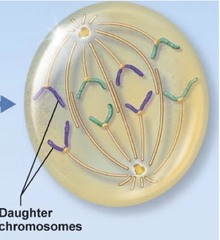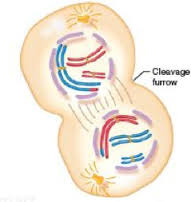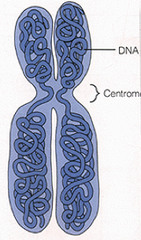cell division -cancer-mitosis – Flashcards
Unlock all answers in this set
Unlock answersquestion
the process by which a cell divides into two new daughter cells
answer
cell division
question
1. DNA overload 2. Too difficult to exchange materials
answer
why cells divide
question
inside volume increases faster than the outside surface area
answer
as a cell gets larger...
question
a reproductive process that involves only one parent and produces offspring that are identical to the parent
answer
asexual reproduction
question
a form of asexual reproduction in which one cell divides to form two identical cells; reproduction in prokaryotes
answer
binary fission
question
in eukaryotic cells, a process of cell division that forms two new nuclei, each of which has the same number of chromosomes as the parent cell; division of the nucleus
answer
mitosis
question
The final stage of the cell cycle, in which the cell's cytoplasm divides, distributing the organelles into each of the two new cells
answer
. cytokinesis
question
growth, repair, cancer
answer
mitosis in multicellular organisms
question
proteins that regulate the timing of the cell cycle in eukaryotic cells
answer
cyclins
question
granular material visible within the nucleus; consists of DNA tightly coiled around proteins
answer
chromatin
question
condensed threads of genetic material formed from chromatin as a cell prepares to divide
answer
chromosome
question
one of two identical sister parts of a duplicated chromosome; chromosome "kid"
answer
chromatid
question
series of events that cells go through as they grow and divide
answer
cell cycle
question
One of two tiny structures located in the cytoplasm of animal cells near the nuclear envelope; play a role in cell division
answer
centrioles
question
special microtubules used in mitosis; connect to chromosomes at the centromere and move the chromosomes around
answer
spindle fibers
question
disk containing cell wall material that develops in plant cells during cytokinesis, eventually dividing the cell into two daughter cells
answer
cell plate
question
any malignant growth or tumor caused by abnormal and uncontrolled cell division
answer
cancer
question
the most common cancer in the US; primary cause is exposure to UVA and UVB rays from the sun
answer
skin cancer
question
the most deadly cancer in the US
answer
lung cancer
question
any change in a DNA sequence that affects genetic information
answer
mutation
question
any agent (physical or environmental) that can cause a genetic mutation or can increase the rate of mutation
answer
mutagen
question
programmed cell death
answer
apotosis
question
an abnormal new mass of tissue that serves no purpose
answer
tumor
question
A mass of abnormal cells that remains at the site of origin; does not metatasize
answer
benign tumor
question
an abnormal tissue mass that can spread into neighboring tissue and to other parts of the body; a cancerous tumor
answer
malignant tumor
question
Secondary tumor growth outside the primary site of cancer
answer
metatasis
question
surgery, radiation therapy, chemotherapy, hormone therapy, and biological therapy
answer
methods of treating cancer
question
Cell cycle
answer
The stages that take place between the time a eukaryotic cell divides and the time the daughter cells divide. (stages of growth, preparation, and division (Interphase and Mitosis)
question
Cancer
answer
A malignant growth or tumor caused by abnormal, uncontrolled cell division.
question
Interphase
answer
Cell grows, performs its normal functions, and prepares for division; consists of G1, S, and G2 phases. (Period of normal growth and maintenance. (3 stages)
question
G1
answer
In interphase - cell grows rapidly, builds new organelles; also performs regular cell functions
question
S phase
answer
The "synthesis" phase of the cell cycle; the portion of interphase during which DNA is replicated. (doubles each chromosomes)
question
G2
answer
Final preparation phase. Cell checks for DNA errors and begins to form centrosomes. (Prepares for Mitosis)
question
Mitosis
answer
1 diploid parent cell splits into 2 identical diploid daughter cells.
question
In order to grow, why do cells divide to make more cells instead of just getting bigger? Reason # 1
answer
Large cells would have to wait too long to diffuse nutrients in and waste out.
question
In order to grow, why do cells divide to make more cells instead of just getting bigger? Reason # 2
answer
One set of DNA can't make enough proteins and enzymes fast enough for a large cell.
question
In order to grow, why do cells divide to make more cells instead of just getting bigger? Reason # 3
answer
The volume of a cell increases a lot faster than the membrane. Too much volume for the surface area and the cell membrane will burst.
question
Prophase
answer
Nucleolus has disappeared, and duplicated chromosomes are visible. Centrosomes begin moving apart, and spindle is in process of forming.
question
Prophase
answer
-the chromosomes coil up and become visible while the nuclear envelope disappears. -Sister chromatids are present. A centriole forms at each pole and spindle fibers made of microtubules grow out of it. -Short microtubules stick out from the centriole in a star shape known as an aster.
question
Prometaphase
answer
-Early in metaphase -spindle fibers attach to each chromatid using the kinetochore.
question
Metaphase
answer
Centromeres of duplicated chromosomes are aligned at plate. Fully formed spindle attach to the sister chromatids from opposite poles
question
Metaphase

answer
Second phase of mitosis, during which the chromosomes line up across the center of the cell
question
Anaphase

answer
Third phase of mitosis in which sister chromatids are pulled to opposite sides of the cell
question
Anaphase
answer
-The kinetochores "reel in" or "gobble up" the spindle fibers -This pulls the sister chromatids apart by splitting their centromere. The split chromatids are pulled towards opposite poles of the cell
question
Telophase

answer
The fourth and final stage of mitosis, in which nuclei are forming and cytokinesis has typically begun.
question
Telophase
answer
-Chromosomes become indistinct -Daughter cells are forming -Once the chromatids have reached the opposite sides the spindle fibers disappear -The chromosomes unravel -nuclear envelope reappears on the two new nuclei
question
Cytokinesis
answer
the cytoplasm forms a cleavage furrow at the equator to split the cytoplasm. (in plants a cell plate forms at the equator.)
question
Chromatids

answer
Bodies of tightly coiled chromatin; visible during cell division. Two chromatids bound at a centromere make a CHROMOSOME.
question
Spindle fibers
answer
Special strands of microtubules which grow out of the centrioles, connect to chromosomes at the centromeres, and pull them apart during (anaphase) of mitosis.
question
Chromosomes
answer
DNA that is coiled together and condensed into small packages (like DNA suitcases) (each has 23 from mom, 23 from dad). Consists of 2 "sister" chromatids bound at a centromere.
question
Chromatin
answer
unpackaged unwound DNA in the nucleus of a cell
question
Diploid
answer
a cell with 2 sets of chromosomes, one from one parent and one set from the other parent. (somatic cells..."soma" means "body")
question
Karyotype
answer
-A micrograph (microscope photograph) of the chromosomes of a human -First 22 pairs are called autosomes. -Last pair are the sex chromosomes (x and y)
question
Centromere
answer
holds sister chromatids together.
question
Cell cycle consists of these three phases
answer
Interphase, mitosis and cytokinesis.
question
Phase of cell cycle that is much longer than the other three.
answer
Interphase--cell growth and development, duplicating DNA and organelles to get ready for division.
question
Part of cell cycle that is the shortest, after mitosis is complete.
answer
Cytokinesis
question
Occurs after telophase (after mitosis is complete) to complete the cell cycle.
answer
cytokinesis.



